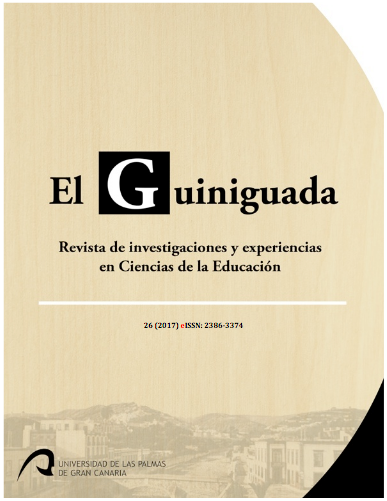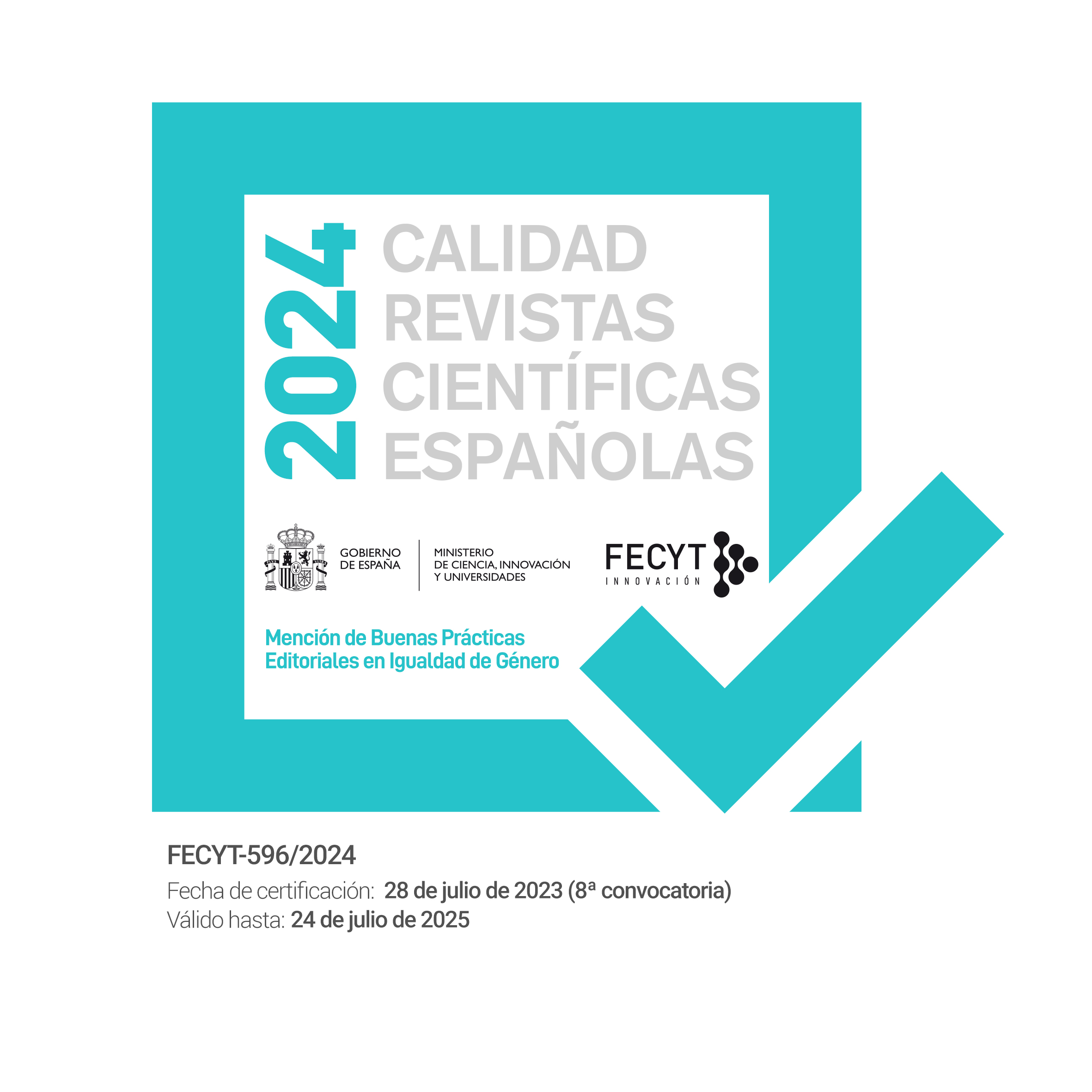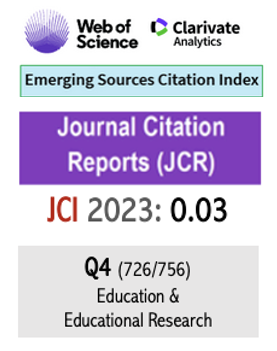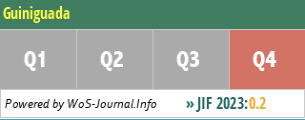Propuesta metodológica para la creación de materiales bilingües (AICLE) en Educación Infantil. Methodological proposal to design bilingual teaching resources (CLIL) in Early Childhood Education. doi 10.20420/ElGuiniguada.2017.138
Keywords:
educación bilingüe, materiales, AICLE, Educación InfantilAbstract
La enseñanza de las segundas lenguas es, junto a la educación bilingüe e intercultural, uno de los ejes educativos con mayor relevancia e importancia en el panorama global. La Comisión Europea, por ejemplo, afirma que la diversidad lingüística y cultural es un valor esencial. Quedan cuestiones esenciales que mejorar, muchas de ellas concernientes a la metodología de enseñanza de lenguas, el contexto y la edad de inicio del alumnado. Sin embargo, existe una demostrada deficiencia de materiales educativos apropiados para el alumnado de Educación Infantil. Este artículo ofrecerá una propuesta metodológica basada en AICLE (Aprendizaje Integrado de Contenidos y Lenguas Extranjeras) para el diseño de materiales bilingües (inglés-español) destinada al profesorado que trabaja con alumnado de edades tempranas y basada en el trabajo colaborativo.
Downloads
References
Abdeliah-Bauer, B. (2007). El desafío del bilingüismo. Madrid: Editorial Morata.
Aguirre, R. (2010). La lectura y la escritura en escolares de primeros grados. Orientaciones Didácticas. Recuperado de www.saber.ula.ve/bitstream/123456789/.../orientaciones_didacticas.pdf [Consultado el 12 de agosto de 2016].
Anderson, L. W., Krathwohl, D. R. y Bloom, B. S. (Eds.) (2001). A Taxonomy for Learning, Teaching, and Assessing: A Revision of Bloom’s Taxonomy of Educational Objectives. New York: Longmont.
Ainscow, M. et al. (2001). Crear condiciones para la mejora del trabajo en el aula. Madrid: Narcea Ediciones.
Arnberg, L. (1981). Early childhood bilingualism in the mixed-lingual family: Summary (No. 14). Linköping University, Dept. of Education.
Baker, C. (1997). Fundamentos de educación bilingüe y bilingüismo. Madrid: Editorial Cátedra.
Bialystok E. (2001). Bilingualism in Development. Language, Literacy & Cognition. New York: Cambridge University Press.
Cabezas, J. M. (2010). A SWOT analysis of the Andalusian Plurilingualism Promotion Plan (APPP). En M. L. Pérez Cañado (Ed.), Proceedings of the 23rd GRETA Convention (pp. 83-91). Jaén: Joxman.
Cazden, C. B. (1991). El discurso en el aula: el lenguaje de la enseñanza y del aprendizaje. Barcelona: Paidós Ibérica.
Coyle, D. (2007). Content and Language Integrated Learning: Towards a connected agenda for CLIL pedagogies. International Journal of Bilingual Education and Bilingualism, 10(5), 543-562.
Cummins, J. (1980). The Cross Lingual Dimensions of Language Proficiency. Implications for Bilingual Education and the Optimal Age Issue. Tesol Quaterly, 14(2), 175-187.
Deller, S. y Price, C. (2007). Teaching Other Subjects through English. Oxford: Oxford University Press.
Flor, A. y Baker C. (2001). Guía para Padres y Maestros de niños bilingües. Bristol: Multilingual Matters.
Francesch, J. D. y i Cirera, J. V. (1997). La organización del espacio y del tiempo en el centro educativo. Barcelona: Graó.
Gómez, Mª E. (2016). Diseño de materiales bilingües e interculturales en educación infantil. Mª I. Amor Almedina, J. L. Luengo-Almena y M. Martínez Atienza (Eds.), Educación Intercultural: metodología de aprendizaje en contextos bilingües (pp. 39-47). Granada: Atrio.
Guitert, M. y Giménez, F. (2000). El trabajo cooperativo en entornos virtuales de aprendizaje. J. M. Duart y A. Sangra (Eds.), Aprender en la virtualidad (pp. 113-134). Barcelona: Gedisa.
Johnson, D. W., Johnson, R. T. y Holubec, E. (1999). El aprendizaje cooperativo en el aula. Barcelona: Paidós Ibérica.
Lancaster, N. K. (2016). Stakeholder Perspectives on CLIL in a Monolingual Context. English Language Teaching, 9(2), 148-177.
Marsh, D. (1994). Bilingual Education & Content and Language Integrated Learning. Paris: International Association for Cross-cultural Communication, Language Teaching in the Member States of the European Union (Lingua), Universidad de la Sorbonne.
Marsh, D., Mehisto, P., Wolff, D., Aliaga, R., Asikainen, T., Frigols-Martín, M. J., Hughes, S. y Langé, G. (Eds.) (2009). CLIL Practice: Perspectives from the Field. Rovaniemi/Jyväskylä: CLIL Cascade Network/University of Jyväskylä.
Mehisto, P. (2012). Criteria for Producing CLIL Learning Material. Online Submission. Encuentro, 21, 15-33.
Mehisto, P., Marsh, D. y Frigols, M. J. (2008). Uncovering CLIL: Content and Language Integrated Learning in Bilingual and Multilingual Education. Oxford: Macmillan.
Meyer, O. (2010). Towards quality CLIL: successful planning and teaching strategies. Pulso, 33, 11-29.
Nickel, H. (1982). Psicología de la conducta del profesor. Barcelona: Herder.
Oxford, R. L., Holloway, M. E. y Horton-Murrillo, D. (1992). Language learning styles: Research and practical considerations for teaching in the multicultural tertiary ESL/EFL classroom. System, 20(4), 439-456.
Piaget, J. (1972). The Psychology of Intelligence. Totowa, NJ: Littlefield.
Rodríguez, M. (2005). Materiales y Recursos en educación infantil. Manual de usos prácticos para el docente. Vigo: Ideaspropias Editorial.
Rogers, C., Pérez, M. P. y Municio, J. I. P. (1987). Psicología social de la enseñanza. Madrid: Visor.
UNESCO. (1974). Resolución 18 C/1.41: Cooperación con las organizaciones internacionales no gubernamentales que se ocupan de educación.
Zabalza, M. A. y Beraza, M. A. Z. (1996). Calidad en la educación infantil. Madrid: Narcea Ediciones.
Published
How to Cite
Issue
Section
License
Authors who publish with this journal agree to the following terms:
- Authors retain copyright and grant the journal right of first publication with the work simultaneously licensed under a Creative Commons Attribution License that allows others to share the work with an acknowledgement of the work's authorship and initial publication in this journal. You can not make a commercial use of the work. The use derived from the work is also not allowed.
- Authors are able to enter into separate, additional contractual arrangements for the non-exclusive distribution of the journal's published version of the work (e.g., post it to an institutional repository or publish it in a book), with an acknowledgement of its initial publication in this journal.
- Authors are permitted and encouraged to post their work online (e.g., in institutional repositories or on their website) prior to and during the submission process, as it can lead to productive exchanges, as well as earlier and greater citation of published work (See The Effect of Open Access).
















